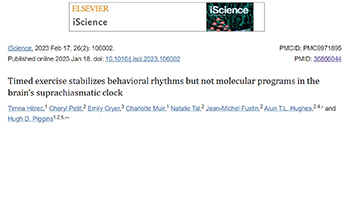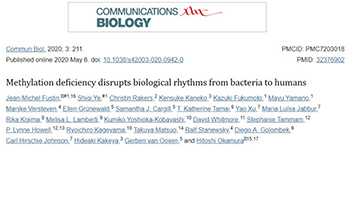The Meth Lab
We use molecular and behavioural circadian rhythms to study genetic and diet-induced metabolic disorders

Dr Jean-Michel Fustin
Future Leaders Fellow
+44 (0)161 306 7589
Jean-Michel.Fustin@Manchester.ac.uk

Dr Benjamin Saer
Senior Research Technician
+44 (0)161 305 5264
Ben.Saer@Manchester.ac.uk

Ms Jess Treeby
PhD student (1st year)

Ms Milla Volic
Biological Sciences BSc UG project

Ms Feifan Shi
MSc Clinical Biochemistry
Alumnus

Ms Sophie Maddock
MSc Clinical Biochemistry
Alumnus

Efficiently delivering exogenous materials into primary neurons and neural stem cells (NSCs) has long been a challenge in neurobiology. Existing methods have struggled with complex protocols, unreliable reproducibility, high immunogenicity, and cytotoxicity, causing a huge conundrum and hindering in-depth analyses. Here, we establish a cutting-edge method for transfecting primary neurons and NSCs, named teleofection, by a two-step process to enhance the formation of biocompatible calcium phosphate (CaP) nanoparticles. Teleofection enables both nucleic acid and protein transfection into primary neurons and NSCs, eliminating the need for specialized skills and equipment. It can easily fine-tune transfection efficiency by adjusting the incubation time and nanoparticle quantity, catering to various experimental requirements. Teleofection’s versatility allows for the delivery of different cargos into the same cell culture, whether simultaneously or sequentially. This flexibility proves invaluable for long-term studies, enabling the monitoring of neural development and synapse plasticity. Moreover, teleofection ensures the consistent and robust expression of delivered genes, facilitating molecular and biochemical investigations. Teleofection represents a significant advancement in neurobiology, which has promise to transcend the limitations of current gene delivery methods. It offers a user-friendly, cost-effective, and reproducible approach for researchers, potentially revolutionizing our understanding of brain function and development.

The feeding/fasting cycles controlled by our circadian clock impose great daily metabolic and physiological changes, and yet investigations into the consequences of metabolic deficiencies, either dietary or genetic, have often ignored the time of day or the circadian time of the animals or subjects. In addition, these deficiencies may themselves disrupt our circadian clock, causing secondary metabolic, physiological and behavioural disorders. Dietary methionine/choline deficiency in rodents is a common model for human non-alcoholic steatohepatitis, but methionine and choline are nutrients essential for many other processes beyond fatty acid synthesis in the liver, including biological methylations and 1-carbon metabolism, regulation of translation notably via the mTOR pathway, phospholipid synthesis, polyamine pathway and glutathione synthesis. We have previously shown that circadian rhythms in many organisms are highly sensitive to deficiency or excesses of 1-carbon metabolites. Using a methionine/choline deficient diet in mice, we illustrate the nutrigenomic crosstalk between circadian rhythms and 1-carbon metabolism. We show not only that circadian locomotor activity behaviour is profoundly, rapidly and reversibly affected by methionine/choline deficiency, but also that the effects of methionine/choline deficiency on gene expression and 1-carbon metabolites are dependent on circadian time, illustrating the importance of considering circadian rhythms in metabolic studies. This study also highlights the impact of what we eat, or don't, on our behaviour and biological rhythms.

Timed daily access to a running-wheel (scheduled voluntary exercise; SVE) synchronizes rodent circadian rhythms and promotes stable, 24h rhythms in animals with genetically targeted impairment of neuropeptide signaling (Vipr2−/− mice). Here we used RNA-seq and/or qRT-PCR to assess how this neuropeptide signaling impairment as well as SVE shapes molecular programs in the brain clock (suprachiasmatic nuclei; SCN) and peripheral tissues (liver and lung). Compared to Vipr2+/+ animals, the SCN transcriptome of Vipr2−/− mice showed extensive dysregulation which included core clock components, transcription factors, and neurochemicals. Furthermore, although SVE stabilized behavioral rhythms in these animals, the SCN transcriptome remained dysregulated. The molecular programs in the lung and liver of Vipr2−/− mice were partially intact, although their response to SVE differed to that of these peripheral tissues in the Vipr2+/+ mice. These findings highlight that SVE can correct behavioral abnormalities in circadian rhythms without causing large scale alterations to the SCN transcriptome.

Methylation, that is, the transfer or synthesis of a -CH3 group onto a target molecule, is a pervasive biochemical modification found in organisms from bacteria to humans. In mammals, a complex metabolic pathway powered by the essential nutrients vitamin B9 and B12, methionine and choline, synthesizes S-adenosylmethionine, the methyl donor in the methylation of nucleic acids, proteins, fatty acids, and small molecules by over 200 substrate-specific methyltransferases described so far in humans. Methylations not only play a key role in scenarios for the origin and evolution of life, but they remain essential for the development and physiology of organisms alive today, and methylation deficiencies contribute to the etiology of many pathologies. The methylation of histones and DNA is important for circadian rhythms in many organisms, and global inhibition of methyl metabolism similarly affects biological rhythms in prokaryotes and eukaryotes. These observations, together with various pieces of evidence scattered in the literature on circadian gene expression and metabolism, indicate a close mutual interdependence between biological rhythms and methyl metabolism that may originate from prebiotic chemistry. This perspective first proposes an abiogenetic scenario for rhythmic methylations and then outlines mammalian methyl metabolism, before reanalyzing previously published data to draw a tentative map of its profound connections with the circadian clock.

The global dietary supplement market is valued at over USD 100 billion. One popular dietary supplement, S-adenosylmethionine, is marketed to improve joints, liver health and emotional well-being in the US since 1999, and has been a prescription drug in Europe to treat depression and arthritis since 1975, but recent studies questioned its efficacy. In our body, S-adenosylmethionine is critical for the methylation of nucleic acids, proteins and many other targets. The marketing of SAM implies that more S-adenosylmethionine is better since it would stimulate methylations and improve health. Previously, we have shown that methylation reactions regulate biological rhythms in many organisms. Here, using biological rhythms to assess the effects of exogenous S-adenosylmethionine, we reveal that excess S-adenosylmethionine disrupts rhythms and, rather than promoting methylation, is catabolized to adenine and methylthioadenosine, toxic methylation inhibitors. These findings further our understanding of methyl metabolism and question the safety of S-adenosylmethionine as a supplement.

Hepatocellular carcinoma (HCC) is the most predominant primary malignancy in the liver. Genotoxic and genetic models have revealed that HCC cells are derived from hepatocytes, but where the critical region for tumor foci emergence is and how this transformation occurs are still unclear. Here, hyperpolyploidization of hepatocytes around the centrilobular (CL) region is demonstrated to be closely linked with the development of HCC cells after diethylnitrosamine treatment. We identify the CL region as a dominant lobule for accumulation of hyperpolyploid hepatocytes and preneoplastic tumor foci formation. We also demonstrate that upregulation of Aurkb plays a critical role in promoting hyperpolyploidization. Increase of AURKB phosphorylation is detected on the midbody during cytokinesis, causing abscission failure and hyperpolyploidization. Pharmacological inhibition of AURKB dramatically reduces nucleus size and tumor foci number surrounding the CL region in diethylnitrosamine-treated liver. Our work reveals an intimate molecular link between pathological hyperpolyploidy of CL hepatocytes and transformation into HCC cells.

Circadian gene expression driven by transcription activators CLOCK and BMAL1 is intimately associated with dynamic chromatin remodeling. However, how cellular metabolism directs circadian chromatin remodeling is virtually unexplored. We report that the S-adenosylhomocysteine (SAH) hydrolyzing enzyme adenosylhomocysteinase (AHCY) cyclically associates to CLOCK-BMAL1 at chromatin sites and promotes circadian transcriptional activity. SAH is a potent feedback inhibitor of S-adenosylmethionine (SAM)–dependent methyltransferases, and timely hydrolysis of SAH by AHCY is critical to sustain methylation reactions. We show that AHCY is essential for cyclic H3K4 trimethylation, genome-wide recruitment of BMAL1 to chromatin, and subsequent circadian transcription. Depletion or targeted pharmacological inhibition of AHCY in mammalian cells markedly decreases the amplitude of circadian gene expression. In mice, pharmacological inhibition of AHCY in the hypothalamus alters circadian locomotor activity and rhythmic transcription within the suprachiasmatic nucleus. These results reveal a previously unappreciated connection between cellular metabolism, chromatin dynamics, and circadian regulation.

The methyl cycle is a universal metabolic pathway providing methyl groups for the methylation of nuclei acids and proteins, regulating all aspects of cellular physiology. We have previously shown that methyl cycle inhibition in mammals strongly affects circadian rhythms. Since the methyl cycle and circadian clocks have evolved early during evolution and operate in organisms across the tree of life, we sought to determine whether the link between the two is also conserved. Here, we show that methyl cycle inhibition affects biological rhythms in species ranging from unicellular algae to humans, separated by more than 1 billion years of evolution. In contrast, the cyanobacterial clock is resistant to methyl cycle inhibition, although we demonstrate that methylations themselves regulate circadian rhythms in this organism. Mammalian cells with a rewired bacteria-like methyl cycle are protected, like cyanobacteria, from methyl cycle inhibition, providing interesting new possibilities for the treatment of methylation deficiencies.

Substance marketed online to ease range of joint and liver conditions, and to promote wellbeing, should not be used

Title: Methylation of mRNA as a coupling mechanism between diet, metabolism and the circadian clock.
PI: Dr Jean-Michel Fustin
GBP561,225

Title: Methylation of mRNA as a coupling mechanism between diet, metabolism and the circadian clock.
PI: Dr Jean-Michel Fustin
GBP974,920

Title: Casein kinase 1 delta inhibitors reset the clock to suppress fibrosis.
Co-PI: Dr Jean-Michel Fustin
AUD664,818

Title: Light-tight cabinets and cages for non-invasive circadian locomotor activity rhythm monitoring.
GBP120,000
Copyright © 03/2024 - All Rights Reserved - The Meth Lab
Based on the Nekmit Template by OS Templates
Background picture modified from KEGG